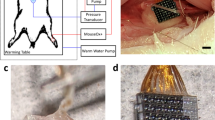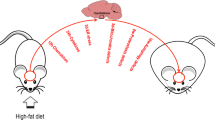Abstract
RECENT findings1 have demonstrated that the ventromedial hypothalamic nuclei act as ‘satiety’ brakes which, in response to certain stimuli (particularly metabolic), inhibit a constantly activated ‘feeding’ mechanism. This mechanism, in turn, appears to be initiated at the level of the anterolateral nuclei2. Destruction of the ventromedial nuclei does not increase hunger (as measured by rate of ingestion); it shortens the pauses between ‘meals’ which, in normal animals, steadily increase during the day so as to constitute a 24-hr, feeding cycle marked with a definite ‘satiety’ pattern1. A method for the destruction of these centres in the rat3, the mouse4 and other species is through the use of stefeotaxic instruments. In the mouse, it has also been shown recently5 that administration of gold thioglucose leads to obesity through injury to the ventromedial nuclei. Such mice and ‘hypothalamic’ rats and mice can thus be used for elucidating whether vitamin deficiencies act by permanently activating the ‘satiety’ mechanism or by inactivating the ‘feeding’ mechanism. For example, one could visualize that thiamine deficiency, the anorexic effect of which is classic, permanently activates the ventromedial nuclei because of the constant elevation of blood concentration of intermediaries of carbohydrate metabolism, or inactivates the feeding mechanism through the action of toxic accumulation of noxious products or because of the lack of carboxylase per se.
This is a preview of subscription content, access via your institution
Access options
Subscribe to this journal
Receive 51 print issues and online access
$199.00 per year
only $3.90 per issue
Buy this article
- Purchase on Springer Link
- Instant access to full article PDF
Prices may be subject to local taxes which are calculated during checkout
Similar content being viewed by others
References
Anliker, J. E., and Mayer, J., Amer. J. App. Physiol. (in the press).
Anand, B. K., and Brobeck, J. R., Yale J. Biol. Med., 24, 141 (1951).
Hetherington, A., Amer. J. Physiol., 133, 326 (1941).
Mayer, J., French, R. G., Zighera, C. Y., and Barnett, R. J., Amer. J. Physiol., 182, 75 (1955).
Marshall, N. B., Barnett, R. J., and Mayer, J., Proc. Soc. Exp. Biol. Med., 90, 240 (1955).
Agnew, L. R. C., Proc. Soc. Exp. Biol. Med., 90, 452 (1955).
Gowgill, G. R., Amer. J. Physiol., 98, 598 (1931).
Goss, H., and Guilbert, H. R., J. Nutrition, 18, 177 (1939).
Mayer, J., and Krehl, W. A., Yale J. Biol. Med., 40, 403 (1948).
Mayer, J., and Krehl, W. A., J. Nutrition, 35, 523 (1948).
Author information
Authors and Affiliations
Rights and permissions
About this article
Cite this article
AGNEW, L., MAYER, J. Mechanism of Anorexia in Vitamin-deficient Hyperphagic Animals. Nature 177, 1235–1236 (1956). https://doi.org/10.1038/1771235b0
Issue Date:
DOI: https://doi.org/10.1038/1771235b0
This article is cited by
-
Effects of oxidized soybean oil on the vitamin A nutrition of the rat
Journal of the American Oil Chemists' Society (1961)
Comments
By submitting a comment you agree to abide by our Terms and Community Guidelines. If you find something abusive or that does not comply with our terms or guidelines please flag it as inappropriate.



